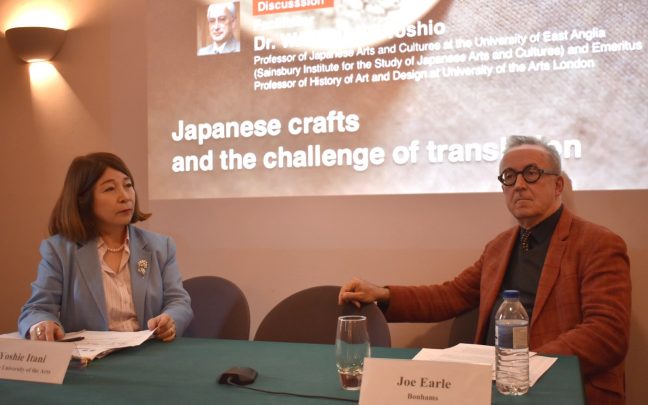 Talk
TalkThursday 9 May 2019
6:00pm – 7:30pm
Japanese crafts and the challenge of translation
ドリンクレセプション 7:30pm – 8:00pm
13/14 Cornwall Terrace, Outer Circle (entrance facing Regent's Park), London NW1 4QP
The Creation of Japan General Incorporated Association in collaboration with the Daiwa Foundation 主催
満席Japanese crafts are highly regarded and valued. However, translating specific craft-related terms is challenging and many of these terms are poorly translated. Interpretations often lack standardization, with the English terminology used to describe Japanese crafts varying depending upon the books or magazines that they appear in. This variation means that it can be difficult for non-Japanese speakers to, for example, research crafts or may even cast doubt on the authenticity of objects. In this talk, two specialists explored the fascinating world of Japanese crafts. They looked at what makes Japanese crafts so special, discussed how they are viewed in an international context and debate translation issues. The audience then had the chance to judge actual translations, based on the case study of Saga Prefecture crafts, and determine if they were accurate explanations or required improvement.
PresentationThis seminar was organised by The Creation of Japan General Incorporated Association. It was sponsored by the Great Britain Sasakawa Foundation and The Tokyo Club along with the support from ANA Saga prefecture.
Listing image credit: ©YASUHIRO OOKAWA
コントリビューターについて
Joe Earle
Joe Earle is senior consultant for Japanese Art at Bonhams. He has worked for nearly 40 years in the field of Asian and Japanese arts and cultures and has occupied senior curatorial positions at top museums in both the United Kingdom and the United States, including at the Victoria and Albert Museum, London, and the Museum of Fine Arts, Boston. He was formerly the Vice-President of Japan Society, New York, and Director of Japan Society Gallery. He has curated, organized, and written catalogues for numerous exhibitions of Japanese art, including: Contemporary Clay: Japanese Ceramics for the New Century (Boston and New York, 2005 and 2006); New Bamboo (New York, 2008); Serizawa: Master of Japanese Textile Design (New York, 2009); Fiber Futures: Japan’s Textile Pioneers (New York, 2011); New Forms, New Voices: Japanese Ceramics from the Gitter-Yelen Collection (New Orleans, 2017); and Glass Mountains, Silver Moon (New York, 2019).
Professor Toshio Watanabe
Professor Toshio Watanabe (Chair) is Professor of Japanese Arts and Cultures at the University of East Anglia (Sainsbury Institute for the Study of Japanese Arts and Cultures) and Emeritus Professor of History of Art and Design at University of the Arts London. He was previously Chair of the Association of Art Historians (1998-2001); a member of the Tate Britain Council (2002-2005); the Director of the Research Centre for Transnational Art, Identity and Nation, UAL (2004-2015); the President of the Japan Art History Forum (2005-2011); and Vice President of Comité international d’histoire de l’art (2010-2016). Some key publications include: High Victorian Japonisme (1991), Japan and Britain: An Aesthetic Dialogue 1850-1930 (1991), Ruskin in Japan 1890-1940: Nature for art, art for life (1997) and East Asian Art History in a Transnational Context (2019).
Yoshie Itani
Yoshie Itani is Project Professor at Tokyo University of the Arts. Her primary research interests are Japanese Modern Art History, with a focus on decorative arts, and Cultural Studies. She has written numerous books including: Agatha Christies and Coffee (2018); Indonesia Kain Party (2018); and Noritake’s Sparkling Export Porcelains (2017). She has also translated A Treatise on Japanning and Varnishing by John Stalker and George Parker (2010) and Urushi Art — Glittering Moments in Time by Mitamura Arisumi (2009).
The Creation of Japan General Incorporated Association
The Creation of Japan General Incorporated Association is a unique non-partisan organisation engaged in multidisciplinary initiatives, with the aim of preserving the ‘crafting beauty’ of Japan for the next century. Looking ahead to 100 years time means building a network of connections across different genres, encompassing everything from the art, culture and fashion of Japan, to urban networks, creators’ associations, schools, craftspeople and manufacturers of materials.